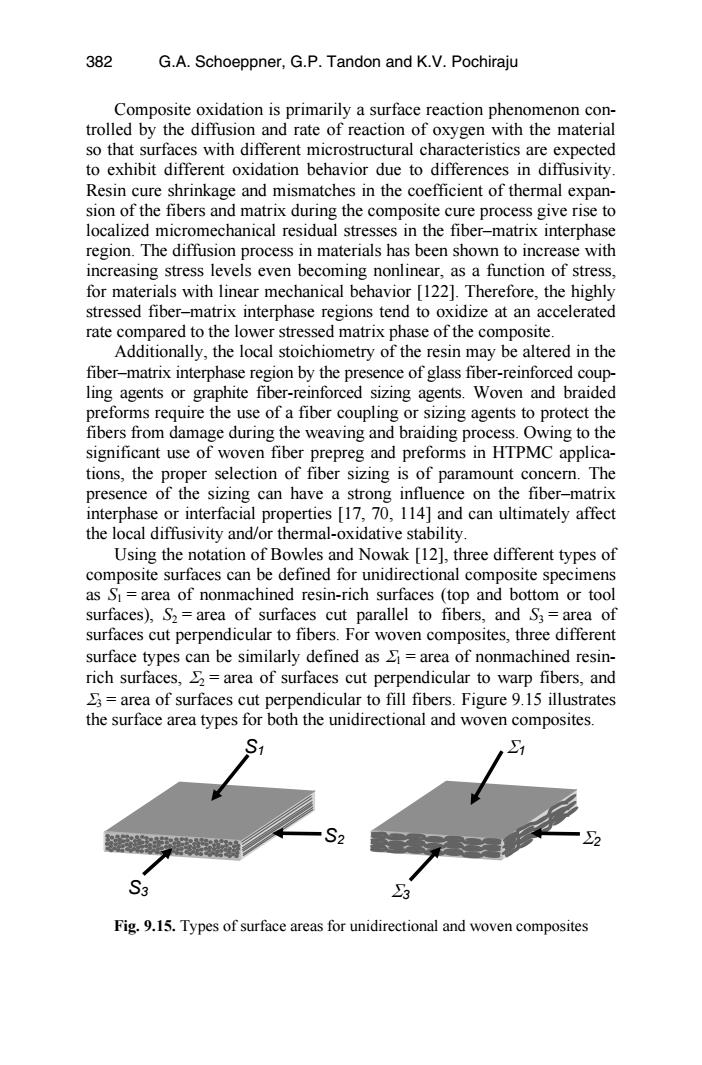正在加载图片...

382 G.A.Schoeppner,G.P.Tandon and K.V.Pochiraju Composite oxidation is primarily a surface reaction phenomenon con- trolled by the diffusion and rate of reaction of oxygen with the material so that surfaces with different microstructural characteristics are expected to exhibit different oxidation behavior due to differences in diffusivity. Resin cure shrinkage and mismatches in the coefficient of thermal expan- sion of the fibers and matrix during the composite cure process give rise to localized micromechanical residual stresses in the fiber-matrix interphase region.The diffusion process in materials has been shown to increase with increasing stress levels even becoming nonlinear,as a function of stress, for materials with linear mechanical behavior [122].Therefore,the highly stressed fiber-matrix interphase regions tend to oxidize at an accelerated rate compared to the lower stressed matrix phase of the composite. Additionally,the local stoichiometry of the resin may be altered in the fiber-matrix interphase region by the presence of glass fiber-reinforced coup- ling agents or graphite fiber-reinforced sizing agents.Woven and braided preforms require the use of a fiber coupling or sizing agents to protect the fibers from damage during the weaving and braiding process.Owing to the significant use of woven fiber prepreg and preforms in HTPMC applica- tions,the proper selection of fiber sizing is of paramount concern.The presence of the sizing can have a strong influence on the fiber-matrix interphase or interfacial properties [17,70,114]and can ultimately affect the local diffusivity and/or thermal-oxidative stability. Using the notation of Bowles and Nowak [12],three different types of composite surfaces can be defined for unidirectional composite specimens as S1=area of nonmachined resin-rich surfaces (top and bottom or tool surfaces),S2=area of surfaces cut parallel to fibers,and S3=area of surfaces cut perpendicular to fibers.For woven composites,three different surface types can be similarly defined as i=area of nonmachined resin- rich surfaces,=area of surfaces cut perpendicular to warp fibers,and =area of surfaces cut perpendicular to fill fibers.Figure 9.15 illustrates the surface area types for both the unidirectional and woven composites. S3 Fig.9.15.Types of surface areas for unidirectional and woven compositesso that surfaces with different microstructural characteristics are expected to exhibit different oxidation behavior due to differences in diffusivity. Resin cure shrinkage and mismatches in the coefficient of thermal expansion of the fibers and matrix during the composite cure process give rise to localized micromechanical residual stresses in the fiber–matrix interphase region. The diffusion process in materials has been shown to increase with increasing stress levels even becoming nonlinear, as a function of stress, for materials with linear mechanical behavior [122]. Therefore, the highly stressed fiber–matrix interphase regions tend to oxidize at an accelerated rate compared to the lower stressed matrix phase of the composite. Additionally, the local stoichiometry of the resin may be altered in the fiber–matrix interphase region by the presence of glass fiber-reinforced coupling agents or graphite fiber-reinforced sizing agents. Woven and braided preforms require the use of a fiber coupling or sizing agents to protect the fibers from damage during the weaving and braiding process. Owing to the significant use of woven fiber prepreg and preforms in HTPMC applications, the proper selection of fiber sizing is of paramount concern. The presence of the sizing can have a strong influence on the fiber–matrix interphase or interfacial properties [17, 70, 114] and can ultimately affect the local diffusivity and/or thermal-oxidative stability. Using the notation of Bowles and Nowak [12], three different types of composite surfaces can be defined for unidirectional composite specimens as S1 = area of nonmachined resin-rich surfaces (top and bottom or tool surfaces), S2 = area of surfaces cut parallel to fibers, and S3 = area of surfaces cut perpendicular to fibers. For woven composites, three different surface types can be similarly defined as Σ1 = area of nonmachined resinrich surfaces, Σ2 = area of surfaces cut perpendicular to warp fibers, and Σ3 = area of surfaces cut perpendicular to fill fibers. Figure 9.15 illustrates the surface area types for both the unidirectional and woven composites. Fig. 9.15. Types of surface areas for unidirectional and woven composites Σ2 Σ3 S1 S2 S3 Σ1 Composite oxidation is primarily a surface reaction phenomenon controlled by the diffusion and rate of reaction of oxygen with the material 382 G.A. Schoeppner, G.P. Tandon and K.V. Pochiraju